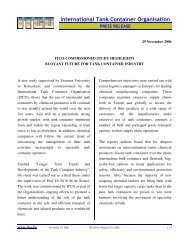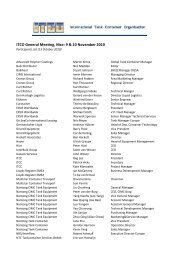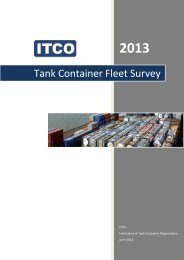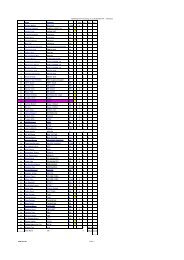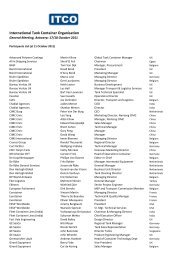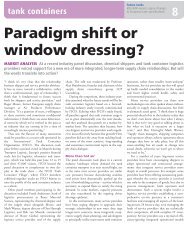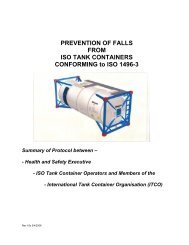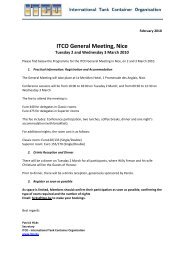You also want an ePaper? Increase the reach of your titles
YUMPU automatically turns print PDFs into web optimized ePapers that Google loves.
ICHCA International <strong>Safe</strong>ty Panel Briefing Pamphlet No 30<br />
A2.3 Ullage<br />
A2.3.1 In the case <strong>of</strong> tank containers, ullage makes up the difference between full<br />
and the degree <strong>of</strong> filling which is defined for hazardous cargoes as per the<br />
previous section.<br />
A2.3.2 For non regulated cargoes there are no formal requirements for ullage or the<br />
degree <strong>of</strong> filling. However similar rules should apply, with each tank<br />
between 80 and 97% filled. However many containers are shipped with the<br />
residue <strong>of</strong> the cargo on their way to be cleaned. In these cases the container<br />
should not be more than 20% full.<br />
A2.3.3 <strong>Tank</strong> containers must not be shipped unless they comply with the<br />
appropriate regulations for cargo fillings as explained in this pamphlet.<br />
Under no circumstances should incorrectly loaded tank containers be<br />
accepted for any form <strong>of</strong> transport; road, rail or sea.<br />
A2.4 Free Surface Effect<br />
A2.4.1 The free surface effect is one <strong>of</strong> several mechanisms where an incorrectly<br />
filled tank container on a rail wagon or chassis / trailer, can become unstable<br />
and roll-over. It refers to the tendency <strong>of</strong> liquids to move in response to<br />
changes in the attitude <strong>of</strong> cargo holds, decks, chassis, wagons or liquid<br />
tanks in reaction to operator-induced motions.<br />
A2.4.2 ADR, IMDG and UN all have recommendations about the filling <strong>of</strong> tank<br />
containers (see also paragraph 3.3.1). All tank containers should be filled to<br />
comply with these regulations and therefore the surging <strong>of</strong> the cargo as the<br />
tank container is moved should usually not adversely affect the cargo<br />
handler.<br />
A2.4.3 <strong>Containers</strong> which are loaded correctly in line with the degree <strong>of</strong> filling<br />
detailed in Annex 2 section A2.2 will not be affected by free surface effect.<br />
However drivers <strong>of</strong> tractor / trailer combinations carrying a container with a<br />
high centre <strong>of</strong> gravity should be especially careful when changing lanes and<br />
turning tight corners, especially if travelling relatively fast or making sharp<br />
manoeuvres.<br />
A2.4.4 Drivers <strong>of</strong> cargo handling equipment and hauliers should not transport tank<br />
containers which are greater than 20% and less than 80% filled. In such<br />
cases they would experience:<br />
Noticeable surging <strong>of</strong> the cargo if the tank container is filled<br />
between 70 and 80%<br />
Severe surging <strong>of</strong> the cargo if the tank container is filled between<br />
60 and 70%<br />
Dangerous surging <strong>of</strong> the cargo if the tank container is filled<br />
between 40 and 60%, to the extent that the tank container will be<br />
unstable once it is in motion.<br />
Note: <strong>ITCO</strong> recommends that tank containers which are not filled<br />
correctly should be stopped and the Shipper notified immediately.<br />
Page 52 ©ICHCA International Limited



